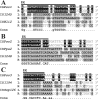Identification and distribution of insertion sequences of Paracoccus solventivorans
- PMID: 14660342
- PMCID: PMC310034
- DOI: 10.1128/AEM.69.12.7002-7008.2003
Identification and distribution of insertion sequences of Paracoccus solventivorans
Abstract
Three novel insertion sequences (ISs) (ISPso1, ISPso2, and ISPso3) of the soil bacterium Paracoccus solventivorans DSM 11592 were identified by transposition into entrapment vector pMEC1. ISPso1 (1,400 bp) carries one large open reading frame (ORF) encoding a putative basic protein (with a DDE motif conserved among transposases [Tnps] of elements belonging to the IS256 family) with the highest levels of similarity with the hypothetical Tnps of Rhodospirillum rubrum and Sphingopyxis macrogoltabida. ISPso2 (832 bp) appeared to be closely related to ISPpa2 of Paracoccus pantotrophus DSM 11072 and IS1248 of Paracoccus denitrificans PdX22, both of which belong to the IS427 group (IS5 family). These elements contain two overlapping ORFs and a putative frameshift motif (AAAAG) responsible for production of a putative transframe Tnp. ISPso3 (1,286 bp) contains a single ORF, whose putative product showed homology with Tnps of ISs classified as members of a distinct subgroup of the IS5 group of the IS5 family. The highest levels of similarity were observed with ISSsp126 of Sphingomonas sp. and IS1169 of Bacteroides fragilis. Analysis of the distribution of ISs of P. solventivorans revealed that ISPso2-like elements are the most widely spread of the elements in nine species of the genus PARACOCCUS: ISPso1 and ISPso3 are present in only a few paracoccal strains, which suggests that they were acquired by lateral transfer. Phylogenetic analysis of Tnps of the novel ISs and their closest relatives showed their evolutionary relationships and possible directions of lateral transfer between various bacterial hosts.
Figures




Similar articles
-
Identification and characterization of transposable elements of Paracoccus pantotrophus.J Bacteriol. 2003 Jul;185(13):3753-63. doi: 10.1128/JB.185.13.3753-3763.2003. J Bacteriol. 2003. PMID: 12813068 Free PMC article.
-
Molecular characterization of functional modules of plasmid pWKS1 of Paracoccus pantotrophus DSM 11072.Microbiology (Reading). 2002 Sep;148(Pt 9):2847-2856. doi: 10.1099/00221287-148-9-2847. Microbiology (Reading). 2002. PMID: 12213930
-
Identification of a transposable genomic island of Paracoccus pantotrophus DSM 11072 by its transposition to a novel entrapment vector pMMB2.Microbiology (Reading). 2006 Apr;152(Pt 4):1063-1073. doi: 10.1099/mic.0.28603-0. Microbiology (Reading). 2006. PMID: 16549670
-
Isolation and characterization of a novel insertion sequence element, IS1248, in Paracoccus denitrificans.Plasmid. 1995 Jul;34(1):11-21. doi: 10.1006/plas.1995.1029. Plasmid. 1995. PMID: 7480167
-
Insertion sequence diversity in archaea.Microbiol Mol Biol Rev. 2007 Mar;71(1):121-57. doi: 10.1128/MMBR.00031-06. Microbiol Mol Biol Rev. 2007. PMID: 17347521 Free PMC article. Review.
Cited by
-
A novel identified Pseudomonas aeruginosa, which exhibited nitrate- and nitrite-dependent methane oxidation abilities, could alleviate the disadvantages caused by nitrate supplementation in rumen fluid fermentation.Microb Biotechnol. 2021 Jul;14(4):1397-1408. doi: 10.1111/1751-7915.13726. Epub 2020 Dec 11. Microb Biotechnol. 2021. PMID: 33305892 Free PMC article.
-
Performance and Application of 16S rRNA Gene Cycle Sequencing for Routine Identification of Bacteria in the Clinical Microbiology Laboratory.Clin Microbiol Rev. 2020 Sep 9;33(4):e00053-19. doi: 10.1128/CMR.00053-19. Print 2020 Sep 16. Clin Microbiol Rev. 2020. PMID: 32907806 Free PMC article. Review.
-
Insights into the transposable mobilome of Paracoccus spp. (Alphaproteobacteria).PLoS One. 2012;7(2):e32277. doi: 10.1371/journal.pone.0032277. Epub 2012 Feb 16. PLoS One. 2012. PMID: 22359677 Free PMC article.
-
Three novel bacteriophages isolated from the East African Rift Valley soda lakes.Virol J. 2016 Dec 3;13(1):204. doi: 10.1186/s12985-016-0656-6. Virol J. 2016. PMID: 27912769 Free PMC article.
-
Bioengineered Graphene Oxide Microcomposites Containing Metabolically Versatile Paracoccus sp. MKU1 for Enhanced Catechol Degradation.ACS Omega. 2020 Jul 1;5(27):16752-16761. doi: 10.1021/acsomega.0c01693. eCollection 2020 Jul 14. ACS Omega. 2020. PMID: 32685843 Free PMC article.
References
-
- Baj, J. 2000. Taxonomy of the genus Paracoccus. Acta Microbiol. Pol. 49:185-200. - PubMed
-
- Baj, J., E. Piechucka, D. Bartosik, and M. Wlodarczyk. 2000. Plasmid occurrence and diversity in the genus Paracoccus. Acta Microbiol. Pol. 49:265-270. - PubMed
-
- Beijerinck, M., and D. C. J. Minkman. 1910. Bildung und Verbrauch von Stickoxydul durch Bakterien. Zentralbl. Bakteriol. Parasitenkd. Infektionsk. 25:30-63.
-
- Berry, A., D. Janssens, M. Humbelin, J. P. Jore, B. Hoste, I. Cleenwerck, M. Vancanneyt, W. Bretzel, A. F. Mayer, R. Lopez-Ulibarri, B. Shanmugam, J. Swings, and L. Pasamontes. 2003. Paracoccus zeaxanthinifaciens sp. nov., a zeaxanthin-producing bacterium. Int. J. Syst. Evol. Microbiol. 53:231-238. - PubMed
Publication types
MeSH terms
Substances
Associated data
- Actions
- Actions
- Actions
LinkOut - more resources
Full Text Sources
Molecular Biology Databases

